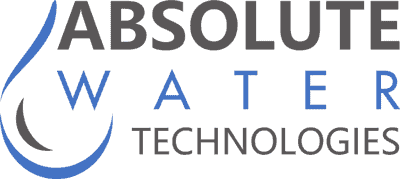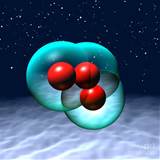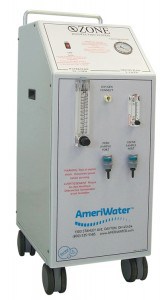Proper Use of Ozone Disinfection / Sanitization in High Purity and Ultra-Pure Water Treatment
process for producing ozone. Ozone is manufactured by drawing oxygen (O2) into the ozone generator and exposing it to multiple high voltage electrical discharges. This causes a percentage of the oxygen molecules to dissociate and reassemble as ozone (O3). The ozone is drawn into the water by a venturi injector / mixer allowing the ozone to be injected into the water under a vacuum condition. A pressure differential must be maintained across the venturi injector. This pressure causes a vacuum that is measured on the vacuum gauge. The gauge should read between –3” and –8” Hg when the system is in normal operation. The Ozone Disinfection System provides microbial reduction by a combination of disinfection by ozone and by physical removal by draining, flushing, and refilling the systems with fresh, purified water.
Ozone is a form of naturally occurring oxygen possessing three atoms of oxygen per molecule instead of the normal two-atom oxygen molecule. Ozone is created by either lightning, electrical charges, or ultra-violet radiation. Ozone is commonly found in our atmosphere, such as the ozone layer of the atmosphere protects us from over-exposure to the sun.
Ozone has a relatively short life span before it reverts back to harmless oxygen. While active, ozone is 52% stronger and 3,125 times faster (in water) than chlorine as a disinfectant. Since it is much more effective than chlorine in destroying water-borne contaminants, ozone has become the preferred method of water treatment for over 4,000 large cities worldwide.
Ozone is recognized by the U.S. Environmental Protection Agency as a viable water treatment alternative to chlorine, and the FDA has added ozone to its list of disinfectants approved “Generally Recognized as Safe.” Ozone is the most powerful and rapid acting oxidizer disinfectant produced, and will oxidize all bacteria, endotoxin and biofilms it comes in contact with in medical piping and water systems.
How Is It Generated?
Although all ozone generators have different capabilities and slightly different designs, the premise is the same. Most use a high technology corona discharge.
Why is it favorable?
Although used in a variety of applications one of the most exciting new uses is in the area of Hemodialysis. Approved under the FDA 510K certification program the Ameriwater Ozone generation system is quickly becoming a sanitization method of choice, and why? Ozone disinfection is safer due to its quick dissipation rates, has a very strong kill rate to meet and exceed AAMI and CMS guidelines, is quicker to perform versus a chemical sanitization, and is cost effective for an operation with a payback over a very short time due to chemical cost savings and labor savings.
Non-dialysis applications have used ozone for some time. Based on the size of a loop and complexity, ozone works efficiently in many applications. Limitations may relate to piping materials and other machinery components, however as listed below. In many applications it can be the safest, quickest, and most thorough and cost effective way to sanitize a system.
Special Concerns:
Ozone is flammable. Only a qualified technician should operate an Ozone generator. Ozone is a toxic gas above certain high concentrations, and an irritant at lower concentrations. The Occupational Safety and Health Administration (OSHA) regulations state that an individual must not be exposed to a concentration of ozone gas higher than:
1) 0.10 PPM (Parts per Million) by volume over an 8-hour period.
2) 0.20 PPM by volume over a 10-minute period.
The AMERIWATER OZONE DISINFECTION SYSTEM uses a gas off tank to contain any ozone gas not dissolved in the water and an ozone gas destruct device to limit the ozone exposure in the area of use. Ozone has a very short half-life and will decompose to oxygen in less than 5 hours. The human nose can detect the ozone odor at .02 PPM, which is 5 times lower than the OSHA safe level. Absolute Water Technologies (an approved Ameriwater Dealer) is trained in this area and can help you with ozone sanitization needs. Contact us for a complete menu of sanitization services and technical advice on loop and complete system sanitizations.
Piping Considerations:
Ozone is one of the strongest oxidizing agents currently available for water treatment, so great care should be taken to ensure that all piping, valves, gaskets, and other materials used in the water treatment system that will come in contact with ozone are resistant to the concentrations of ozone present during disinfection. Just about all the materials except filter cartridges and membranes used in the typical water system are acceptable.
Below is a list of materials that are compatible for ozone concentrations up to 6 PPM in water.
Piping: Gaskets & Seals:
304L Stainless Steel Kel-F 2800
316L Stainless Steel Kal-Rez
PTFE (Teflon) Chem-Rez
ETFE (Teflon) Gortex
ECTFE (Halar) Teflon tape
PVDF (Kynar) Hypalon
CPVC Schedule 80 Viton
PVC Schedule 80 Silicon
HDPE (Polyethylene) EPDM
PP (Polypropylene)
NOTE: Natural rubber and many plastic and synthetic rubbers cannot be used as gaskets, seals, or O-rings in combination with ozone. Exposure to ozone will cause these components to become brittle and crack.
Contact Absolute Water Technologies for a quote of an ozone generation system of your own, or for sanitization services.



